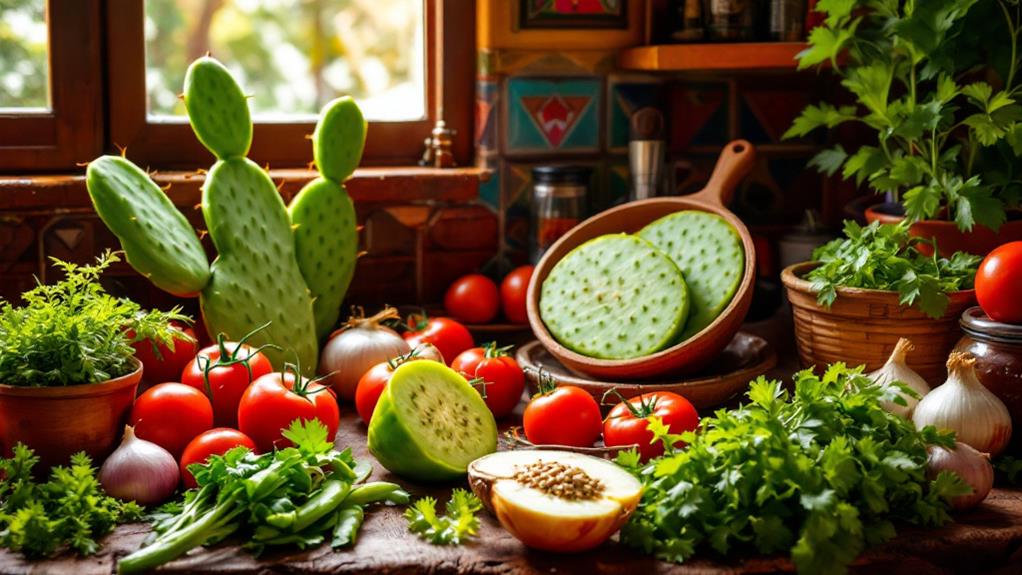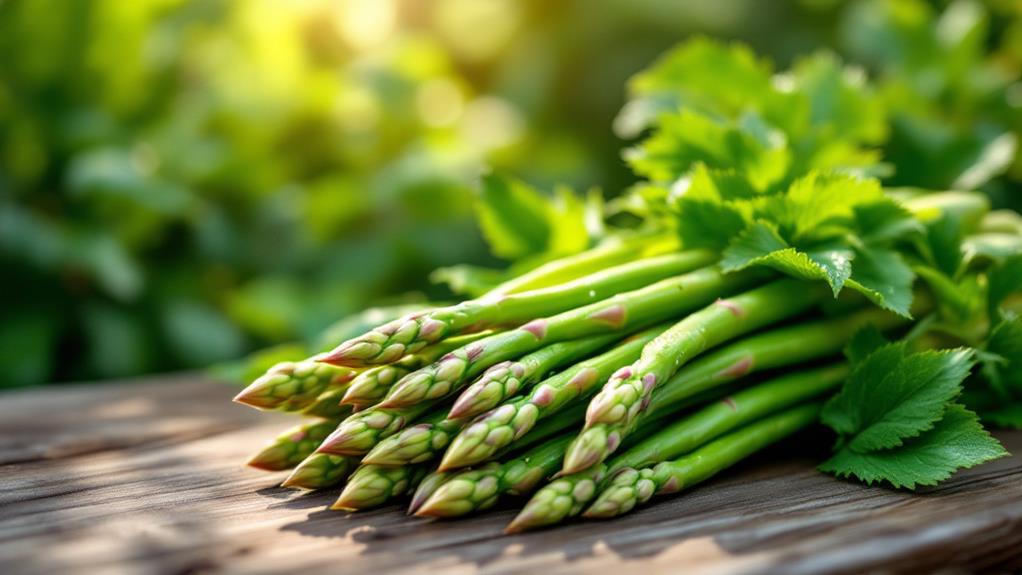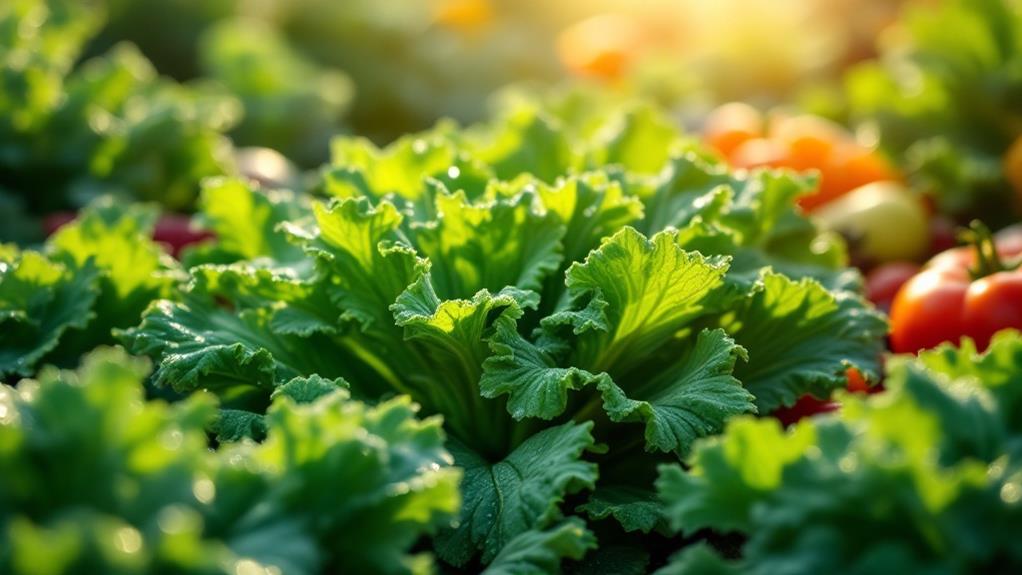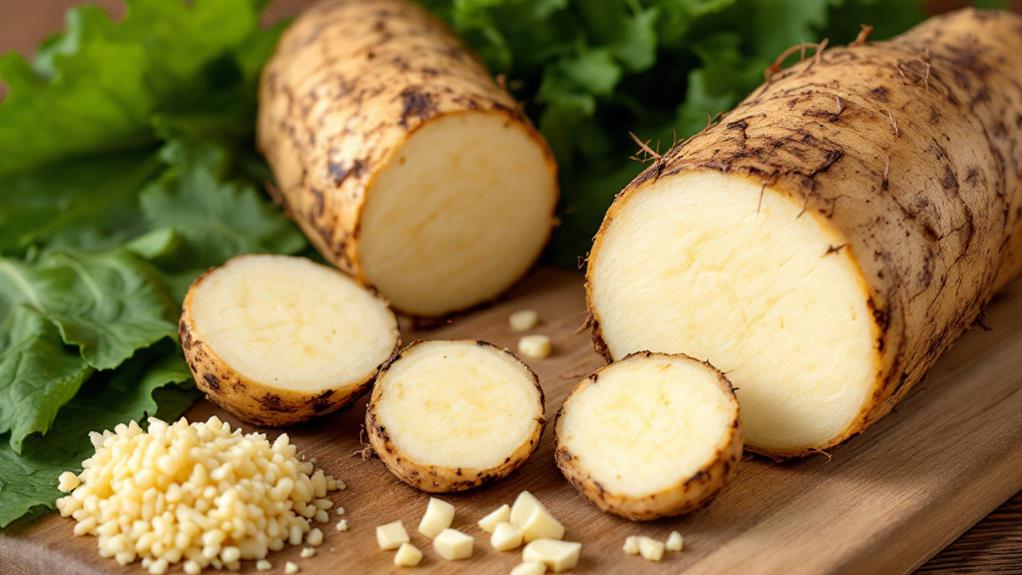Everything You Need to Know About Ambarella: Uses, Health Benefits, and Growing Guide
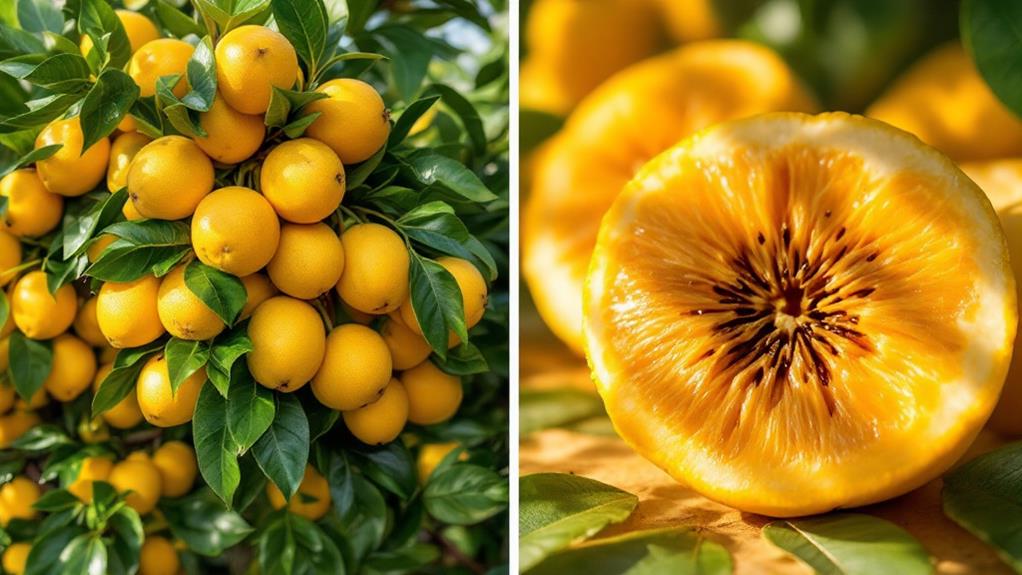
Ambarella, also known as Spondias dulcis, is a tropical fruit with numerous uses and health benefits. You can enjoy it raw, in salads, smoothies, or as jams and pickles. It's low in calories and packed with vitamins A and C, enhancing immune function and supporting vision. With 2g of dietary fiber per serving, it promotes digestive health and helps with weight management. It thrives in tropical climates, needing well-drained soil, full sun, and temperatures between 18°C and 30°C. If you're curious about growing your own or integrating ambarella into your diet, there's much more to uncover.
Overview of Ambarella
Ambarella, often known as Spondias dulcis, is a tropical fruit tree that's native to Melanesia and Polynesia. This impressive tree can reach heights of 20-30 meters and is renowned for its deciduous leaves and small white flowers. As a tropical fruit, Ambarella thrives in tropical and subtropical climates, favoring well-drained soil and full sun. If you're considering growing it, aim for a soil pH between 5.5 and 7.5 for ideal results.
This fruit offers significant health benefits. It's rich in vitamin C and dietary fiber, which makes it a fantastic choice for enhancing your immune support and improving digestive health. Including Ambarella in your diet can provide crucial nutrients and contribute to general well-being.
Culinary uses of Ambarella are varied and lively. You can enjoy it fresh for a tangy treat or incorporate it into jams and pickles. Its versatility shines in tropical cuisines, where it's a staple ingredient in many dishes. Regardless of you're savoring it as a golden-yellow ripe fruit or exploring its diverse culinary applications, Ambarella stands out as a delightful and nutritious enhancement to your diet.
Nutritional Composition
When looking at the nutritional composition of ambarella, you'll find it offers an impressive array of health benefits in a compact package. The ambarella fruit is a fantastic low-calorie snack, providing just 48 calories per serving. This makes it a great option if you're watching your calorie intake. Despite its low calorie count, it packs a punch with a robust nutritional profile.
Rich in vitamin C, ambarella offers about 30mg per serving, which plays a significant role in supporting your immune system and maintaining skin health. Furthermore, the fruit contains 233 IU of vitamin A, vital for healthy vision and complete eye health. The dietary fiber content, at around 2g per serving, aids in digestive health by promoting gut function and regularity.
In addition, ambarella is a good source of important minerals. It contains 15mg of calcium and 22mg of phosphorus, both of which contribute to bone strength and complete health. These nutrients work together to support numerous bodily functions, making ambarella a well-rounded enhancement to your diet. By including ambarella in your meals, you can enjoy its delightful taste while improving your nutritional intake.
Health Benefits
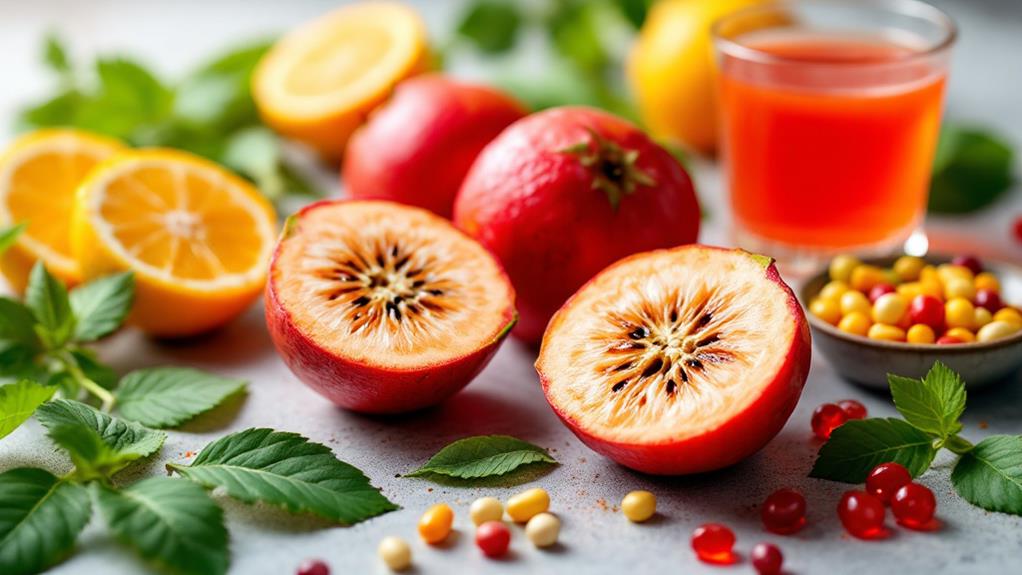
Exploring the health benefits of ambarella reveals its potential to improve your well-being in multiple ways. Initially, its rich vitamin C content—30 mg per serving—boosts your immune function and supports skin health by aiding collagen formation. Including ambarella in your diet can help keep illnesses at bay and maintain a radiant complexion.
Ambarella's high dietary fiber content, approximately 2 grams per serving, plays a significant role in improving digestive health. It alleviates constipation and helps lower cholesterol levels, thereby promoting heart health. These fibers guarantee your digestive system functions smoothly, while also contributing to a heart-healthy lifestyle.
The antioxidants in ambarella, such as flavonoids and terpenoids, combat oxidative stress and may reduce the risk of chronic diseases and premature aging. By incorporating ambarella into your diet, you could potentially lower the risk of ailments linked to oxidative damage.
Furthermore, the low-calorie count of just 48 Kcal per serving makes ambarella a great choice for weight management. It provides vital nutrients like calcium and phosphorus, supporting bone health. Moreover, vitamin A in ambarella (233 IU) improves eye health, reducing the risk of age-related vision issues.
Culinary Uses
Many culinary possibilities await with ambarella, thanks to its crunchy texture and sweet-tart flavor. When you think about ambarella fruits, imagine a versatile ingredient that can enhance your meals. Eaten raw, they make a revitalizing snack, perfect for satisfying a midday craving. But the fruit's versatility doesn't stop there. You can blend it into smoothies, adding not only flavor but also a nutritional enhancement to your drink. The fruit is also an excellent supplement to salads and desserts, thanks to its unique taste and texture.
For those who enjoy a tangy twist, unripe ambarella is commonly pickled or used in chutneys, providing a burst of flavor to complement numerous dishes. On the other hand, ripe fruit shines in jams and jellies, where its natural pectin content helps in creating smooth, spreadable preserves.
Don't overlook the young ambarella leaves. These can be eaten raw in salads or steamed, contributing a nutritious green element to your meals. With ambarella fruits, you're not just adding diversity to your culinary applications; you're also enhancing the nutritional profile of your dishes in delightful ways.
Ambarella for Pregnancy

Packed with important nutrients, ambarella fruit offers significant health benefits for pregnant individuals. Rich in fundamental nutrients like vitamin C and dietary fiber, it supports general health and aids digestion during pregnancy. The fruit's mild diuretic properties are particularly helpful in managing hypertension, a common concern for pregnant people, promoting healthy blood pressure levels.
Ambarella's antioxidant properties contribute to fetal development by potentially reducing oxidative stress, providing a safe environment for your growing baby. Post-pregnancy, the nutrient-dense profile of ambarella can assist recovery by supplying important vitamins and minerals needed for healing. Regular consumption encourages hydration and nutrient absorption, which are critical for both mother and baby's well-being.
Consider these benefits of including ambarella in your diet:
- Vitamin C Enhancement: Supports immune health and collagen formation, essential for fetal development.
- Hypertension Management: Helps maintain healthy blood pressure levels.
- Antioxidant Properties: Reduces oxidative stress, promoting a healthy pregnancy.
- Post-Pregnancy Recovery: Provides fundamental nutrients for healing and energy.
- Improved Hydration: Encourages adequate fluid intake and nutrient absorption.
Incorporating ambarella into your diet can be a delicious and nutritious way to support a healthy pregnancy experience.
Botanical Characteristics
While ambarella boasts numerous health benefits, understanding its botanical characteristics enriches your appreciation of this adaptable fruit. Ambarella, known scientifically as Spondias dulcis, is a tropical tree that can soar up to 20-30 meters in height. It features glossy, compound leaves that create a lush canopy. In addition to its striking foliage, the tree produces small white flowers in large terminal panicles, enhancing its ornamental appeal.
As an ambarella tree matures, it yields oval-shaped fruits with a tough green skin that ripens to a lively golden-yellow. Each fruit contains a single large seed encased within fibrous pulp, making it both nourishing and texturally unique. This tree thrives in tropical and subtropical climates, requiring full sun and well-drained soils for ideal growth. Remarkably, it's adaptable to a range of soil types, including oolitic limestone.
Ambarella is a seasonal crop, typically bearing fruit from September to mid-January in tropical regions. The fruits cluster together, offering a bountiful harvest during its fruiting season. While mature trees have moderate cold tolerance, surviving down to 25°F (-3.9°C), young trees are more susceptible to cold damage.
Growing Conditions
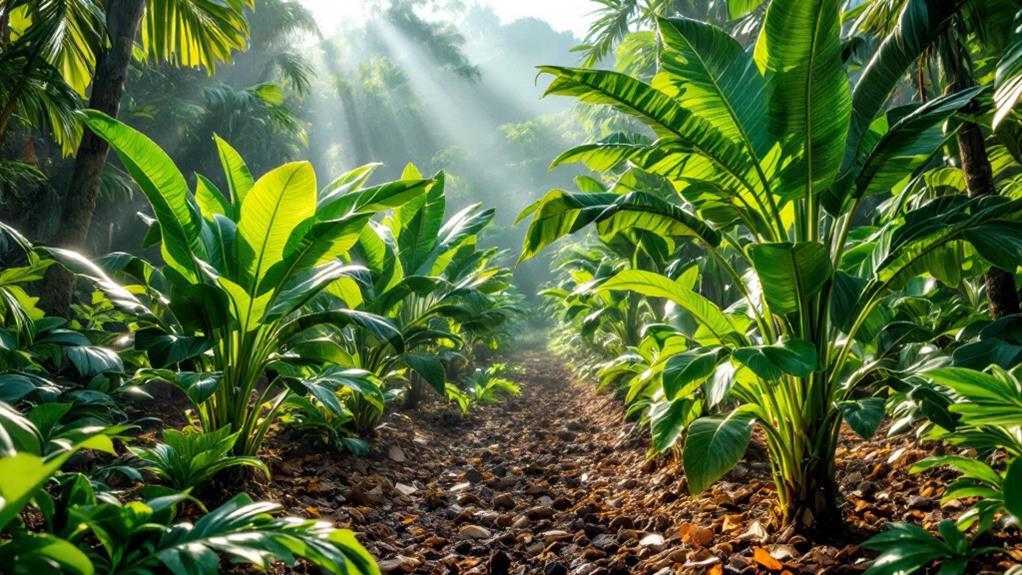
In regards to growing ambarella, success hinges on understanding its specific climatic and soil preferences. This tropical tree, also known as Spondias, flourishes in climates where temperatures range from 18°C to 30°C. For ideal growth, plant ambarella in well-drained soil with a pH between 5.5 and 7.5, accommodating its needs even in oolitic limestone soil. Ensuring full sun exposure is vital, as ambarella requires at least 4-6 hours of direct sunlight daily to produce healthy fruit.
Regular watering is important, especially during dry periods, although mature trees exhibit a commendable level of drought tolerance. This means you won't need to worry too much about watering once the tree is established. To enhance growth and fruiting, practice selective pruning during hot, dry weather, and don't forget to fertilize from June to October to support its development.
Here's a quick checklist for growing ambarella successfully:
- Tropical climate with temperatures between 18°C and 30°C
- Well-drained soil with a pH of 5.5 to 7.5
- Full sun exposure for 4-6 hours daily
- Regular watering, especially during dry spells
- Selective pruning and fertilization for ideal growth
Cultivation Practices
Cultivating ambarella successfully involves understanding and implementing vital practices tailored to this tropical tree's needs. If you're in tropical areas, you'll find ambarella trees thrive best in well-drained soils with a pH between 5.5 and 7.5. Confirming full sun exposure is fundamental for peak growth, so choose a sunny spot for planting. Young trees require regular watering, especially during dry periods, to establish a strong root system. However, as they mature, these trees develop drought tolerance and can withstand temperatures as low as 25°F (-3.9°C).
Selective pruning is a must during hot, dry weather. This practice encourages healthy growth and boosts fruit production. From June to October, consider fertilizing to provide necessary nutrients and support robust development. If you're growing dwarf varieties, fruit thinning might be necessary to prevent stunted growth and guarantee a better yield. This process helps the tree allocate its resources efficiently, resulting in larger, more flavorful fruits.
Ambarella trees are a long-term investment, typically producing fruit for up to 50 years. With proper care and attention, you can enjoy a bountiful harvest, making these trees a valuable supplement to any suitable climate garden.
Cultural Significance

As you nurture your ambarella tree, you're not just cultivating a plant but embracing a piece of cultural heritage rich in tradition and significance. Originating in Southeast Asia, ambarella, also known as kedondong or June plum, holds a special place in the hearts and diets of people in Malaysia and India, where it's considered a staple fruit. Its cultural significance extends beyond just being a food source; ambarella is deeply woven into the fabric of community gatherings and local markets.
In Caribbean cultures, ambarella symbolizes summer and often takes center stage at local festivals and culinary events. Its sweet-tart flavor is celebrated in numerous culinary traditions, appearing in dishes like chutneys, pickles, and salads. In tropical regions, the fruit also plays a role in traditional medicine, with its leaves and bark used to treat ailments such as dysentery and coughs.
Here's what you might find fascinating about ambarella's cultural role:
- Integral to local culinary traditions in Vietnam and the Philippines.
- Featured in community gatherings as a symbol of celebration.
- Sold in lively local markets as a fresh delicacy.
- Used in traditional medicine for its healing properties.
- Versatile in dishes like chutneys and pickles.

